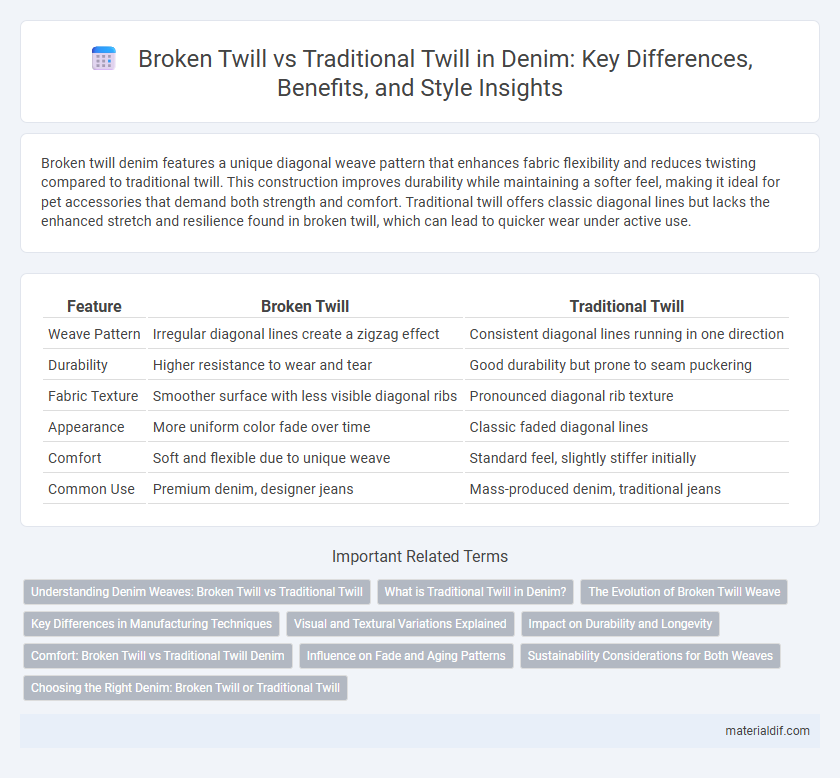Broken twill denim features a unique diagonal weave pattern that enhances fabric flexibility and reduces twisting compared to traditional twill. This construction improves durability while maintaining a softer feel, making it ideal for pet accessories that demand both strength and comfort. Traditional twill offers classic diagonal lines but lacks the enhanced stretch and resilience found in broken twill, which can lead to quicker wear under active use.
Table of Comparison
| Feature | Broken Twill | Traditional Twill |
|---|---|---|
| Weave Pattern | Irregular diagonal lines create a zigzag effect | Consistent diagonal lines running in one direction |
| Durability | Higher resistance to wear and tear | Good durability but prone to seam puckering |
| Fabric Texture | Smoother surface with less visible diagonal ribs | Pronounced diagonal rib texture |
| Appearance | More uniform color fade over time | Classic faded diagonal lines |
| Comfort | Soft and flexible due to unique weave | Standard feel, slightly stiffer initially |
| Common Use | Premium denim, designer jeans | Mass-produced denim, traditional jeans |
Understanding Denim Weaves: Broken Twill vs Traditional Twill
Broken twill denim features a zigzag pattern that reduces the diagonal line visibility, enhancing durability and minimizing fabric distortion over time. Traditional twill displays a consistent diagonal weave, offering a classic look with more visible weave lines, which can fade unevenly through wear. Understanding these differences helps choose denim tailored for longevity or aesthetic preference based on weave structure.
What is Traditional Twill in Denim?
Traditional twill in denim refers to a weaving pattern characterized by diagonal parallel ribs created by passing the weft thread under two or more warp threads. This classic structure enhances fabric durability and gives denim its signature texture and appearance. In contrast to broken twill, traditional twill features consistent diagonal lines that contribute to a uniform surface and lasting strength.
The Evolution of Broken Twill Weave
Broken twill weave has evolved as a distinctive alternative to traditional twill, offering enhanced durability and unique texture by reversing the diagonal pattern at regular intervals. This weave reduces the typical diagonal line found in traditional twill, resulting in a matt surface that resists creasing and shows less wear over time. Modern denim manufacturers favor broken twill for its ability to maintain fabric integrity and provide innovative aesthetic appeal in premium jeans.
Key Differences in Manufacturing Techniques
Broken twill denim features a zigzag weave pattern created by alternating the diagonal direction on the loom, reducing fabric's characteristic diagonal line, while traditional twill employs a consistent diagonal weave. The broken twill technique minimizes bias stretch and improves softness through a more intricate weaving process, enhancing durability and comfort. Traditional twill manufacturing emphasizes a straightforward, commonly used 3/1 or 2/1 weave, making it heavier and less flexible compared to the lightweight, flexible nature of broken twill denim.
Visual and Textural Variations Explained
Broken twill denim features a diagonal weave pattern that shifts direction periodically, creating a distinctive zigzag effect visible on the fabric surface, unlike traditional twill which maintains a consistent diagonal line. This dye pattern variation in broken twill results in a more textured appearance with enhanced depth, offering increased softness and reduced stiffness compared to traditional twill's tighter, more uniform weave. The visual complexity and tactile softness of broken twill make it a sought-after option for denim enthusiasts seeking both unique aesthetics and comfortable wear.
Impact on Durability and Longevity
Broken twill denim features a diagonal weave pattern that reduces stress points, enhancing fabric durability and preventing premature wear compared to traditional twill's uniform diagonal lines. The interrupted weave in broken twill distributes tension more evenly, resulting in longer-lasting jeans that resist tearing and fading. Traditional twill denim, while classic, tends to show wear patterns more quickly due to concentrated stress along the consistent diagonal weave.
Comfort: Broken Twill vs Traditional Twill Denim
Broken twill denim features a diagonal weave pattern that reduces fabric stiffness, offering enhanced comfort and flexibility compared to the tighter, more rigid structure of traditional twill. This weave minimizes the crease lines typical in traditional twill, promoting a softer hand feel and improved breathability, ideal for all-day wear. Denim made from broken twill adapts better to body movement, making it a preferred choice for comfort-focused apparel.
Influence on Fade and Aging Patterns
Broken twill denim features a zigzag weave that distributes tension unevenly, resulting in unique, irregular fading patterns that enhance the fabric's vintage look over time. Traditional twill denim, with its consistent diagonal weave, produces more uniform fades, emphasizing sharp contrast lines known as "whiskers" and "honeycombs." The difference in weave structure significantly influences how denim ages, making broken twill prized for distinctive, personalized wear patterns while traditional twill appeals to those seeking classic, predictable fading characteristics.
Sustainability Considerations for Both Weaves
Broken twill denim features a varied diagonal weave that reduces fabric stress, enhancing durability and extending garment lifespan compared to traditional twill, which has a uniform diagonal pattern. The longer-lasting nature of broken twill denim supports sustainability by decreasing the frequency of replacements and resource consumption. Traditional twill, while classic, may wear out faster, potentially leading to increased textile waste and environmental impact over time.
Choosing the Right Denim: Broken Twill or Traditional Twill
Broken twill denim features a diagonal weave pattern that reduces visible wear lines, providing enhanced durability and a unique textured appearance compared to traditional twill. Traditional twill has a consistent diagonal weave that offers classic fades and a more uniform look, ideal for those seeking a vintage or classic aesthetic. Choosing between broken twill and traditional twill depends on preferences for wear patterns, durability, and visual texture in denim garments.
Broken twill vs Traditional twill Infographic

 materialdif.com
materialdif.com